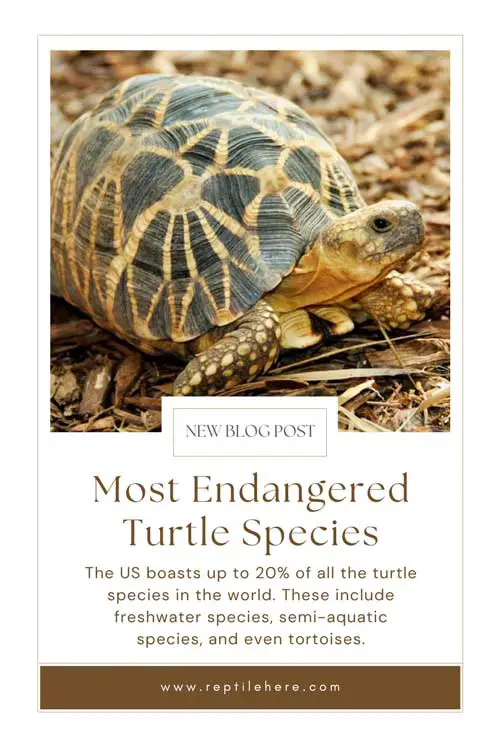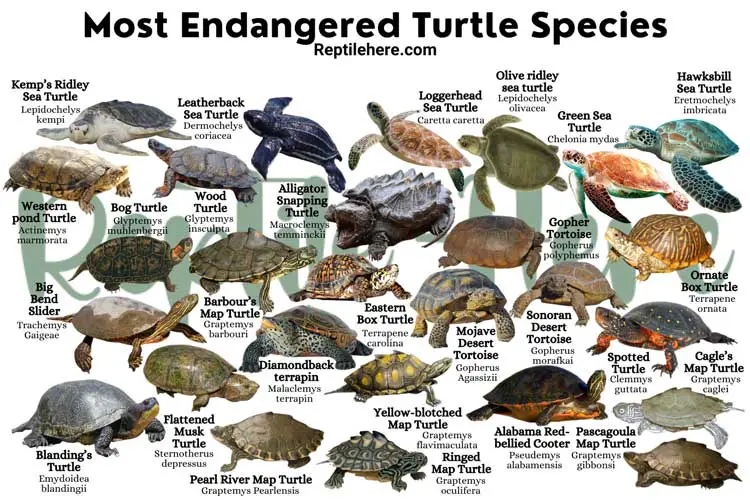Most Endangered Turtle Species
The US boasts up to 20% of all the turtle species in the world. These include freshwater species, semi-aquatic species, and even tortoises. This makes it the only region with more turtle species than any country across the globe.
Unfortunately, most of these turtles are endangered and are listed under the IUCN Red List as Critically Endangered (CR), Endangered (EN), Vulnerable (VU), and Near Threatened (NT).
This is due to their declining populations due to factors such as pet trade, predation, diseases, killing by fishermen, habitat loss and alteration, and road mortality, among others.
In this guide, you’ll discover the most endangered turtle species in the United States that appear in the IUCN (International Union for Conservation of Nature (IUCN) Red List.
1. Alligator Snapping Turtle
Contents
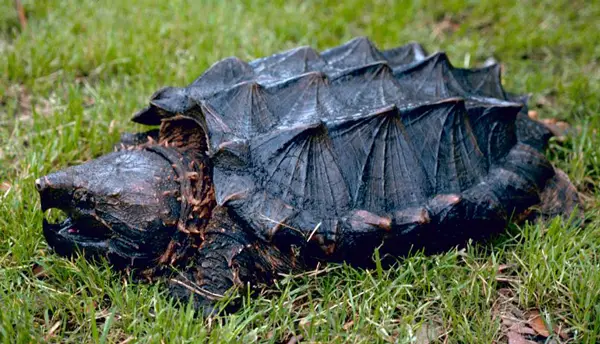
- Scientific name: Macroclemys temminckii
- Common name: Alligator snapping turtle, Snapping turtle
- Family: Chelydridae
- Size: 15 to 26 inches
- Lifespan: 80 to 120 years
- Conservation status: Vulnerable
The alligator snapping turtle is listed as vulnerable. This is because they’re on the decline due to the degradation of their habitat and overharvesting for meat. This has forced some states to impose bans on hunting them in the wild.
This turtle species is larger than the common snapping turtle. An adult alligator snapping turtle weighs 15 to 20 inches long.
An alligator turtle is characterized by a long, tough shell with trigonal ridges that resemble the back of an alligator (hence the name alligator turtle). Shell coloring can be black, olive, or brown.
Though some people believe that the green tips on the shell ridges are natural, they’re simply algae.
These alligator turtles also prefer living in deeper waters of rivers, canals, lakes, and swamps.
As omnivorous species, they hunt their prey (but not actively). They have a unique way of hunting where they lie at the bottom of the water body and open their mouth to show their pink work-like appendage to lure their prey.
And when the prey gets close enough, the turtle ambushes it!
Another interesting fact about this turtle is its powerful jaws which can bite with a force of up to 1000lbs!
This makes them extremely dangerous turtles and should NEVER be handled in the wild! Mind you, they have injured even the most experienced herpetologists with their bites.
2. Western pond Turtle
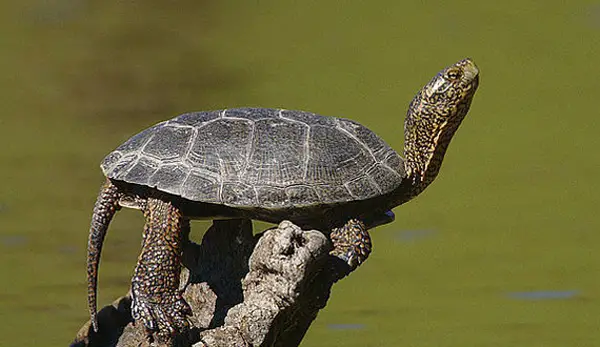
- Scientific name: Actinemys marmorata
- Common name: Western Pond Turtle, Pacific Pond Turtle
- Family: Emydidae
- Size: 6 to 8 inches
- Lifespan: 50 years
- Conservation status: Vulnerable
The western pond turtle has suffered habitat loss due to development, low reproduction, predators, and invasive aggressive non-native pet turtles being released into the wild.
All these factors make the species listed as endangered in most states, including Washington, Oregon, and California.
This species is small-to-medium-sized and is native to Washington, Oregon, Nevada, and California. It prefers living in creeks, ponds, lakes, and other suitable water bodies.
Carapace coloring for this turtle can be black, brown, or dark green, with some yellowish spots. Patterns of lines or dots also usually radiate from the center of each shell plate of this tortoise.
Also, the limbs of a western pond turtle feature prominent scales while its head is webbed or spotted with black.
Western pond turtle species is omnivorous and its diet includes insects, tadpoles, frogs, and even carrion. For this reason, it prefers living in waterbodies with plenty of aquatic vegetation such as cattails, water lilies, watercress, etc.
3. Spotted Turtle
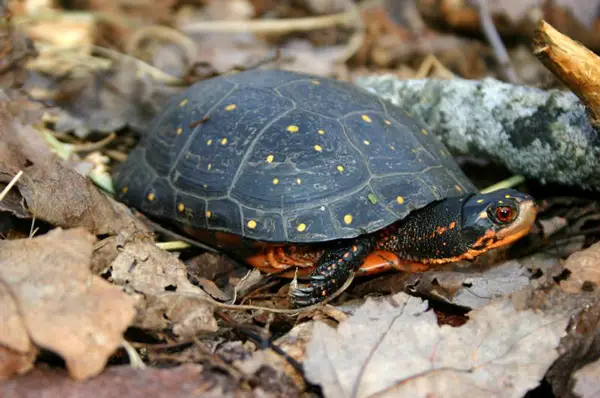
- Scientific name: Clemmys guttata
- Common name: Spotted Turtle
- Family: Emydidae
- Size: 4 to 5 inches
- Lifespan: 25 to 50 years
- Conservation status: Endangered
The Spotted turtle population has also been on the decline due to human interference and habitat loss. Their unique shell patterns make them a favorite species of pet turtle for many people.
For this reason, they’re listed as endangered and protected by many governing bodies across various states.
The turtle resides in shallow marshes, swamps, and bogs. They’re semi-aquatic and are comfortable on land just as they are in the waters.
An adult spotted turtle has a smooth upper shell that ranges from olive to dark brown in color, with some light yellow spots. The neck and head feature irregular orange or yellow spots and streaks. Their tails are fairly long.
The turtles are omnivorous and their diet involves crustaceans, mollusks, insects, and plant matter (occasionally). Note that these turtles are aggressive hunters and will actively seek their prey.
Above all, spotted turtles are incredibly smart. Studies carried on them using a maze even indicate that they have the same brain capacity as the mouse!
4. Wood Turtle
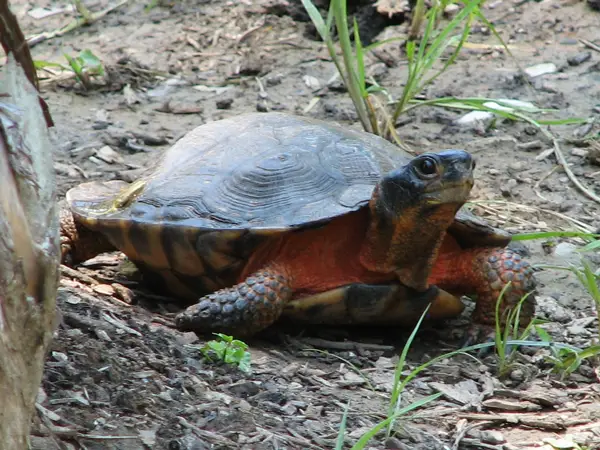
- Scientific name: Glyptemys insculpta
- Common name: Wood turtle, Sculptured Tortoise, Redleg, Red-legged Tortoise
- Family: Emydidae
- Size: 5.5 to 8 inches
- Lifespan: 40 to 60 years
- Conservation status: Endangered
The wood turtle is designated as Endangered species by IUCN. Moreover, the State Wildlife Action Plans in the states this turtle is found in have also labeled it as SGCN (Species of Greatest Conservation Need).
The wood turtle tends to stay near the water and will frequently venture into it. During winter, they tend to hibernate at the bottom of deep rivers and pools.
The turtles get their name from their sculpted-like looks. Their upper shells are dark brown and have sport patterns resembling wood grain and growth rings.
Their scutes may sometimes appear like they’re pyramiding, further enhancing their sculpted shape.
Wood turtles are diurnal omnivores and their diet mainly consists of berries, plants, insects, and mollusks.
They forage for their food widely and have even been observed stomping their feet on the ground as a way of tricking the earthworms into surfacing.
5. Bog Turtle
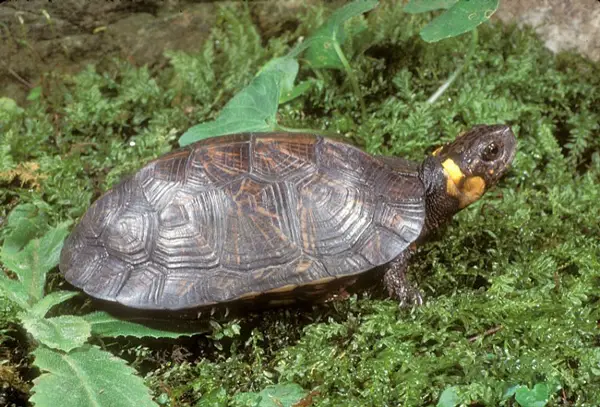
- Scientific name: Glyptemys muhlenbergii
- Common name: Bog Turtle, Muhlenberg’s turtle
- Family: Emydidae
- Size: 3.5 to 5 inches
- Lifespan: up to 40 years
- Conservation status: Critically Endangered
The Bog turtle is the smallest aquatic turtle you’ll find in North America. Add to its cute appearance, and this makes it a hot cake in the pet trade market.
Unfortunately, this species is critically endangered and is one of the rarest turtles in many states. Selling or owning a bog turtle in most US states is illegal!
An adult bog turtle’s carapace coloration ranges from black to olive or dark brown and features a central keel ridge.
Some of the scutes making up their upper shell may also bear red or yellow-star markings. And their heads have distinctive orange or yellow patches.
The bog turtle is known to inhabit wetland areas such as marshes or bogs populated with grass cover.
The turtle species are diurnal omnivores and like eating insects, mollusks, and occasional vegetation. They’re most active during warm parts of the day.
6. Big Bend Slider
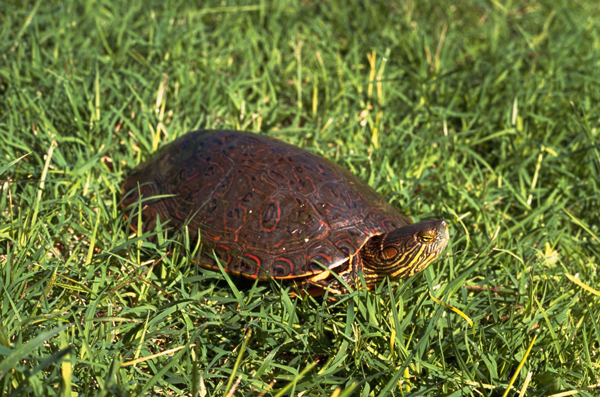
- Scientific name: Trachemys Gaigeae
- Common name: Big Bend Slider, Mexican Plateau Slider
- Family: Emydidae
- Size: 5 to 11 inches
- Lifespan: 20 to 30 years
- Conservation status: Vulnerable
The big bend slider, also known Mexican plateau slider, is another semi-aquatic turtle native to New Mexico and Texas states.
It is pretty close in appearance to its close cousin, the red-eared slider, with the exception that it has fewer red patches around its eyes.
The big bend slider’s upper shell color ranges from olive to dark brown and is covered with a yellow, orange, or red pattern. And the lower side of the shell is yellowish with a few dark spots.
Big bend slider skin color is usually the same as the carapace and is covered in yellow stripes. Two red spots can be easily spotted on each side near its head.
You’ll find this big bend slider in the pond and rivers. The turtle is also fond of basking.
These sliders are mainly herbivorous and like feeding on vegetation as well as fruits, unlike their counterparts (the red-eared sliders) which are omnivorous.
7. Blanding’s Turtle
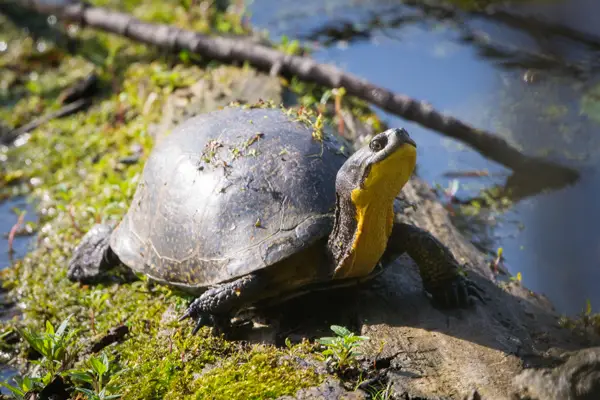
- Scientific name: Emydoidea blandingii
- Common name: Blanding’s Turtle
- Family: Emydidae
- Size: 5 to 8 inches
- Lifespan: up to 80 years (or more!)
- Conservation status: Endangered
Blanding’s turtle has also been labeled as endangered throughout its range, meaning it’s likely to become extinct in the near future. The semi-aquatic turtle’s population is quite scattered across various states—making it hard to find.
The turtle prefers living in marshy habitats. And the fact that it’s losing these favorite habitats is one of the reasons causing its population to decline fast.
Blanding’s Turtle is also known as the “turtle that smiles” and is named in honor of William Blanding, the American naturalist.
The Blanding turtle has a dark oval shell covered with faint yellow speckles. The lower side of its shell is usually yellow with black patches.
Because this turtle species is omnivorous, it feeds on crayfish, and aquatic invertebrates. It also occasionally feeds on plants and doesn’t rely on water to help it sallow its food as it’s the case with most turtle species.
8. Alabama Red-bellied Cooter
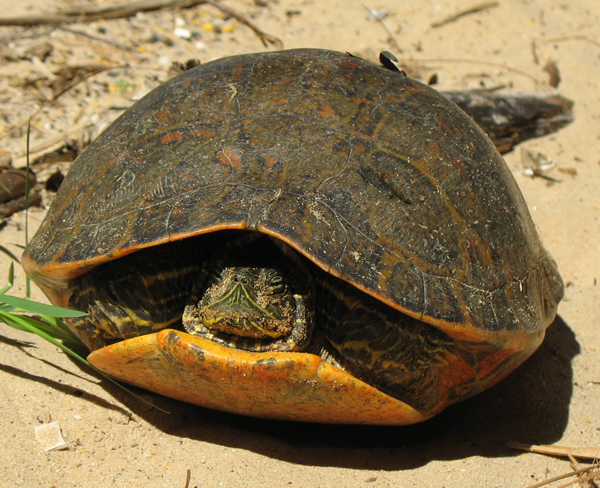
- Scientific name: Pseudemys alabamensis
- Common name: Alabama red-bellied turtle, Red-belly, Slider, Cooter
- Family: Emydidae
- Size: 8 to 12 inches
- Lifespan: 40 to 60 years
- Conservation status: Endangered
Alabama red-belly Cooter lives in the fresh, shallow waters of Alabama and Mississippi states. However, it’s not uncommon to come across one in slightly brackish waters.
These turtle has entered the list of endangered species mainly due to exploitation by humans and habitat loss.
Alabama red-bellied Cooters are average-sized compared to most species and can reach between 8 and 12 inches in length.
The redbelly scooter usually has a dark brown shell color, with some orange or red coloring on its edges. The lower side of the shell is usually red or orange. The turtle’s skin is usually black or dark brown and is covered by orange or yellow stripes.
Young Alabama red-bellied turtles have more intense and bright coloring, but it fades as they age.
The turtles are, mainly herbivorous and fed on aquatic plants, algae, and land vegetation (they feed on this when basking or nesting). Mind you, this turtle is much easier to find when it’s foraging.
Alabama redbelly turtles are quite nervous and like basking on logs in the sun. They quickly retreat back into the water if they feel threatened or disturbed.
9. Diamondback terrapin
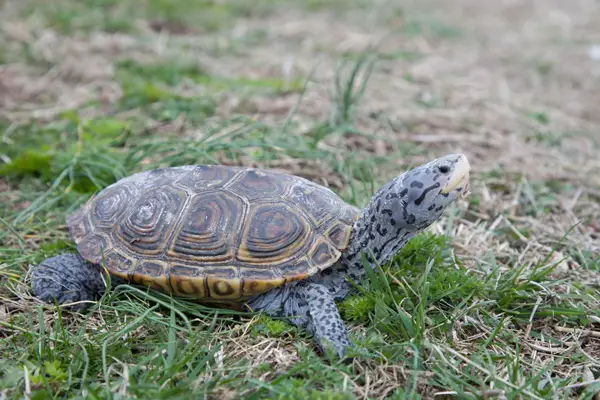
- Scientific name: Malaclemys terrapin
- Common name: Diamondback Terrapin
- Family: Emydidae
- Size: 4 to 6 inches (males), 5 to 8 inches (females)
- Lifespan: 25 to 35 years
- Conservation status: Vulnerable
The diamondback terrapin is listed as a species of special concern by both state and federally. For this reason, you may require a special permit to collect this turtle species.
This terrapin is the only freshwater turtle that can adapt to saltwater as well. Their shells have a raised diamond shape, hence the name diamondback. The term “terrapin” simply means little turtle.
A typical diamondback terrapin has a black-to-brown carapace and yellow lower shell that may sometimes feature dark-colored patterns. The turtle’s skin is usually grey-white with multiple small black spots.
Female diamondback terrapins are usually bigger than their male counterparts.
These turtles are highly timid and can easily get stressed when in captivity. They’re pretty docile and can be handled. However, they’re known to bite as a way of defending themselves if they feel threatened.
Diamondback terrapins can be found along the coast in tidal flats, salt marshes, barrier beaches, and brackish streams. They can also stay in full-strength saltwater for longer periods of time.
The terrapins are largely carnivorous and feed on crustaceans, fish, crabs, shrimps, marine snails, marine worms, mollusks, mussels, clams, and barnacles. However, they also tend to occasionally ingest small amounts of plant matter.
10. Flattened musk turtle
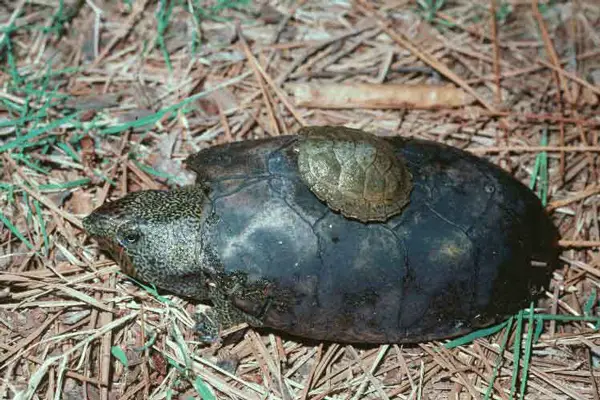
- Scientific name: Sternotherus depressus
- Common name: Musk Turtle
- Family: Kinosternidae
- Size: 3 to 4 inches
- Lifespan: 50 to 60 years
- Conservation status: Critically Endangered
The flattened musk turtle is ONLY found in Alabama. To be more precise, it lives in the Black Warrior river system, located in west-central Alabama.
Flattened musk turtles are protected given that 90% of their habitat has been destroyed as a result of erosion caused by strip mining in their habitat.
This turtle species is quite small (3 to 4 inches long) and differs from other turtles with its carapace shape that’s flat on top, with rounded edges. The scutes on its carapace slightly overlap to give the shell a ridged look.
Flattened musk turtles usually have a dark brown carapace while the lower side of the shell is lighter brown. The skin can be black or dark brown, with numerous olive spots.
The musk turtle species love to eat aquatic insects and mollusks and live in freshwater lakes and rivers.
One interesting fact about these turtles is that they’re believed to have evolved over 15 million years ago before the dinosaurs became extinct.
11. Barbour’s Map Turtle
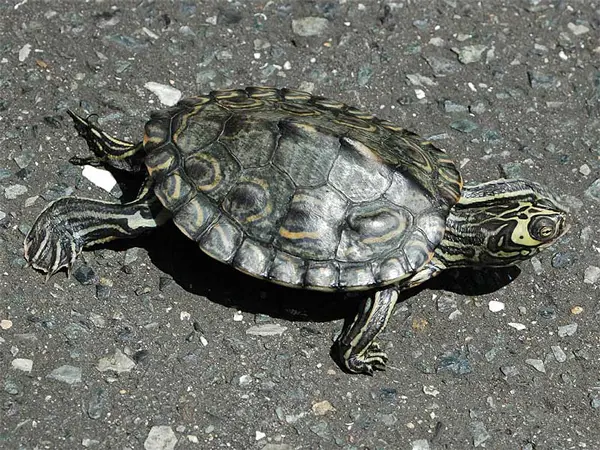
- Scientific name: Graptemys barbouri
- Common name: Barbour Map Turtle, Barbour’s Sawback Turtle
- Family: Emydidae
- Size: 3 to 5 inches (males), 8 to 10 inches (females)
- Lifespan: 30 to 50 years
- Conservation status: Least Concern
The Barbour’s map turtle species is confined to Alabama, Florida, and Georgia and enjoys the protection and has state-threatened spaces in these states.
However, it receives no protection from the federal Endangered Species Act.
Since these turtles are highly nervous, you’re cautioned against handling or approaching them if you see them in the wild. When started, they quickly burrow into the bottom of a waterbody or mud.
Barbour’s map turtle has dark brown or black skin covered with yellow to green markings. And on the upper part of their shell lays the spines—their most distinct feature. Though these spines may vary in size from one turtle to another, they all have got dark tips.
Females are usually larger than females. The females’ heads are way larger compared to those of their male counterparts.
The Barbour’s map turtle prefers living in slow-moving or stagnant lakes, ponds, or streams with a lot of aquatic vegetation. It is omnivorous and feeds on insects and aquatic vegetation.
12. Cagle’s Map Turtle
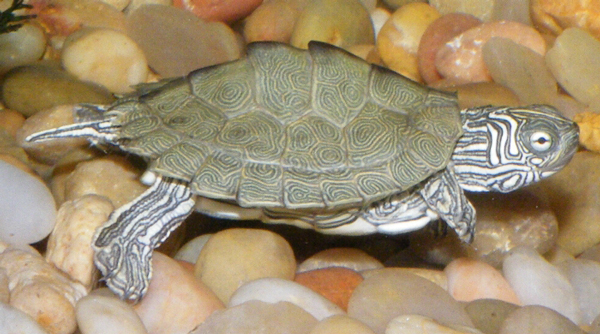
- Scientific name: Graptemys caglei
- Common name: Cagle’s Map Turtle
- Family: Emydidae
- Size: 8 to 10 inches (females), 3 to 5 inches (males)
- Lifespan: 3o to 50 years
- Conservation status: Endangered
The Cagle’s map turtle is native to Texas. However, it has a pretty small population and is only found in the Guadalupe River System in southern Texas.
This is an endangered species and is under protection by Texas regulations.
It gets its name from herpetologist Dr. Fred Ray Cagle. It is somewhat similar to other map turtles in that it has a dark shell with steep keels and serrated rears. It also has cream-to-yellowish spots on its head.
Cagle’s map turtle of Texas is omnivorous, just like other map turtles. It feeds on mollusks, insects, and (occasionally) vegetation.
Nonetheless, the turtle still finds its way to the pet markets. This is due to its small size, eye-pleasing green coloring, and ease of care—these traits are quite rare among map turtles.
13. Yellow-blotched Map Turtle
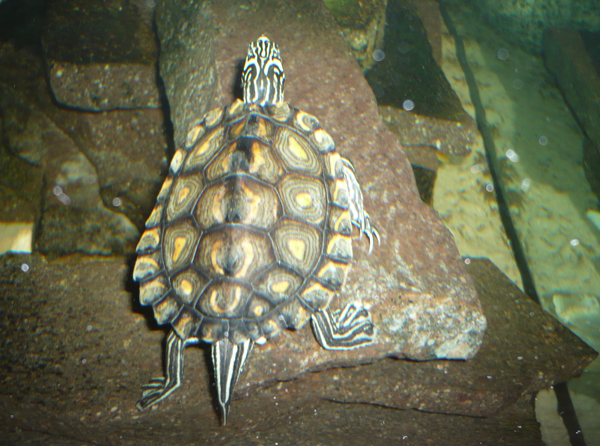
- Scientific name: Graptemys flavimaculata
- Common name: Yellow-blotched Sawback
- Family: Emydidae
- Size: 3.5 to 7.5 inches
- Lifespan: 30 to 50 years
- Conservation status: Endangered
The Yellow-blotched Map Turtle is only found in Mississippi (in Mississippi’s Pascagoula River). It has also been observed in the Escatawpa river.
This turtle is labeled as an endangered species in the US and is under special monitoring.
A Mississippi Yellow-blotched Map Turtle is identified by a green to olive upper shell, with yellow scutes at the center of most of its scutes.
It has a central ridge of prominent keels extending from shell spine. Note that the central keel in this species is the largest that has even been observed in all map turtle species.
Like the other species of map turtles, this Pascagoula map turtle of Mississippi is omnivorous. It mostly feeds on insects, crustaceans, and aquatic plants.
14. Pascagoula Map Turtle
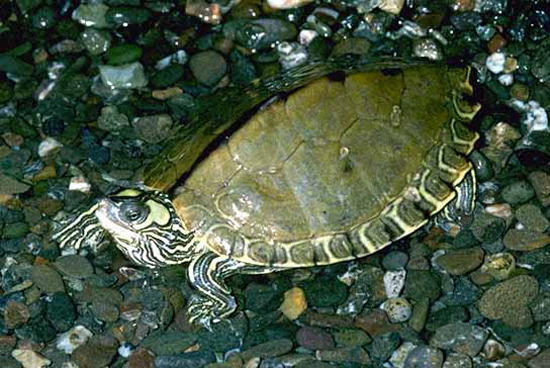
- Scientific name: Graptemys gibbonsi
- Common name: Pascagoula Map Turtle, Pascagoula Sawback
- Family: Emydidae
- Size: 5 to 11.5 inches
- Lifespan: 30 to 50 years
- Conservation status: Endangered
Like the yellow-blotched map turtle above, this map turtle is also found in Mississippi state only.
Due to its restricted habitat, this turtle is classified as endangered and is under special monitoring by the relevant authorities in Mississippi.
It is native to the Pascagoula River, situated in Mississippi’s southeastern regions. It gets its name from Whit Gibbons, an American herpetologist.
The Pascagoula is identified by a brown to the olive shell with protruding keels. It also features yellow stripe markings around its scutes, at the edge of the shell. Both its head and skin are olive with yellowish spots and stripes.
Like the other species of map turtles, this Pascagoula map turtle of Mississippi is omnivorous. It mostly feeds on insects, crustaceans, and aquatic plants.
15. Ringed Map Turtle
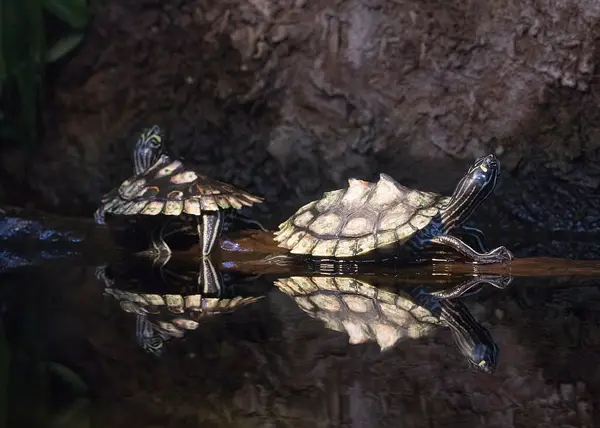
- Scientific name: Graptemys oculifera
- Common name: Ringed Map Turtle, Ringed Sawback
- Family: Emydidae
- Size: 3 to 5 inches (males), 8 to 10 inches (females)
- Lifespan: 30 to 50 years
- Conservation status: Vulnerable
This map turtle shares a range with the Pearl River Map Turtles and is found in Pearl River system in Louisiana and Mississippi states.
In the state of Mississippi, this turtle is mainly concentrated in several eastern counties near Pearl River.
You can easily identify a ring map turtle by looking at its shell. It features prominent light circles on a dark shell background—this is where it gets the name “Ringed” turtle.
The shell color ranges from green to yellowish, with some sharp peaks situated down the center. Also, their shells feature jagged, saw-tooth edges.
This ringed map turtle is omnivorous and loves eating crustaceans, mollusks, and aquatic vegetation. It prefers living in moving waters such as rivers.
16. Pearl River Map Turtle
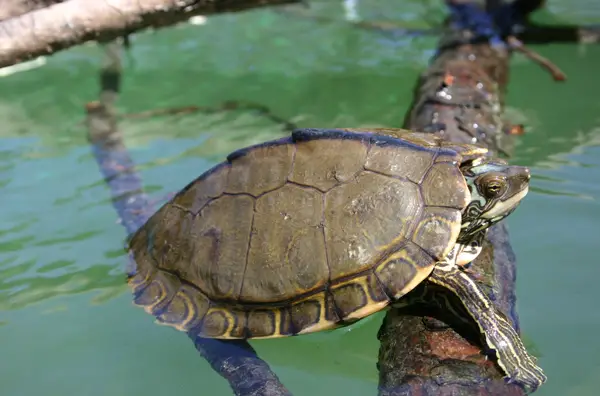
- Scientific name: Graptemys Pearlensis
- Common name: Pearl River Map Turtle
- Family: Emydidae
- Size: 3 to 5 inches (males), 8 to 10 inches (females)
- Lifespan: 30 to 50 years
- Conservation status: Endangered
The Pearl River Map Turtle is native to Pearl River system in Louisiana and Mississippi, hence the name. This rare sub-species of map turtle is native to the Southern United States.
Unfortunately, this turtle is under threat from water pollution and has been labeled as endangered species due to its declining population.
Its upper shell is olive green and features fluted edges with yellow markings. The female usually has a larger head and a flattened, wide beak for crushing food.
Note that it is usually a challenge to tell apart this turtle from some of its close map turtle cousins.
Like the other map turtles, the females are usually larger than the males.
Pearl River Map Turtles are omnivorous and mainly feed on crustacean invertebrates, small fish, and aquatic plants.
17. Green sea turtle
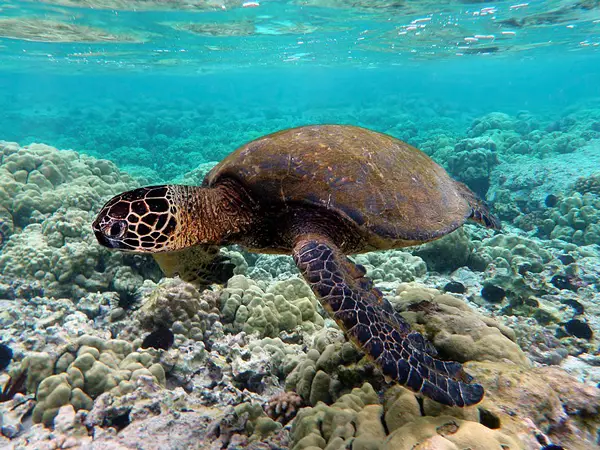
- Scientific name: Terrapene ornata
- Common name: Ornate Box Turtle, Western Box Turtle
- Family: Emydidae
- Size: 5 to 7 inches
- Lifespan: 40 to 60 years
- Conservation status: Near Threatened
The green sea turtle species is classified among the largest hard-shelled sea turtles in the US and is common in states like Texas, Washington, Virginia, South Carolina, Hawaii, Florida, North Carolina, Alabama, and Alaska, among others.
This species is characterized by scutes that run down the middle; they’re 4 on each side. The shell color can be gray, dark brown, or olive with a yellow-to-white bottom shell or plastron.
It also features a serrated beak on its lower jaw and two large scales resign between the eyes.
Males are generally larger than females and have longer tails. The females lay their eggs on the beach and use their paddle-shaped flippers to easily burrow in the sand when laying eggs. A single green turtle can lay up to 200 eggs!
This sea turtle species gets its name from its primary diet which consists of age and seagrasses (mind you, this diet is responsible for tinting its cartilage green).
Green turtles are usually found in tropical as well as subtropical waters throughout the years. They also tend to migrate to cooler temperatures and even boreal waters when the weather gets warmer.
18. Loggerhead sea turtle
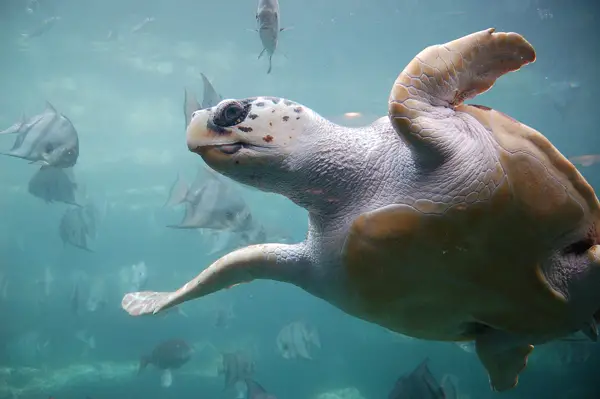
- Scientific name: Caretta caretta
- Common name: Loggerhead, Loggerhead Sea-Turtle
- Family: Cheloniidae
- Size: 3.5 feet
- Lifespan: 70+ years
- Conservation status: Endangered
Loggerhead sea turtles’ biggest threat is bycatch in fishing gear, especially the longlines, trawls, gillnets, and hook and line gear.
The sea turtle boasts its place as the most abundant sea turtle species in the United States and is found in many states, including Rhode Island, Alabama, Florida, Texas, Washington, North Carolina, New Jersey, Oregon, and Virginia.
These turtles are pretty big and can reach up to 3.5ft in length. They weigh up to 350 pounds and can live for a whopping 70 years or more.
A loggerhead is distinguished by a slightly heart-shaped carapace that’s reddish brown in color, with pale yellow plastron. Some species also feature yellow-bordered scutes.
This turtle species gets its name from its large head. It has powerful jaws that enable it to feed on a variety of foods including conch, whelks, insects, jellyfish, gastropods, and algae.
The loggerhead turtles are usually found in temperate, tropical, and subtropical waters all year round. However, they also tend to migrate to cold boreal waters on rare occasions, for instance, during El Nino weather.
19. Kemp’s ridley sea turtle
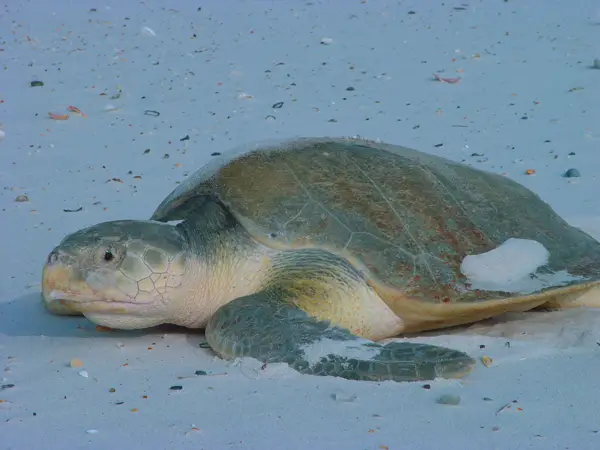
- Scientific name: Lepidochelys kempi
- Common name: Atlantic ridley sea turtle,
- Family: Cheloniidae
- Size: 2+ feet
- Lifespan: 30+ years
- Conservation status: Critically endangered
Kemp’s ridley sea turtle is the smallest species of all sea turtles in the US. It is also the rarest sea turtle species and is one of the world’s most endangered species.
It is listed as critically endangered in the US. Its primary threat is the destruction and consumption of its eggs by both native and non-native predators including raccoons, coyotes, feral pigs, crabs, and birds.
The species is called Kemp’s ridley because Richard Moore Kemp of Key West was the first to send its specimen to Samuel Garman at Harvard university. However, the origin of the name ridley is still unclear.
The average adult size is about 2 feet and weighs approx. 110 lbs. They have adapted flippers (front limbs) and a beak.
Note that these turtles tend to change their color as they age. Baby turtles feature dark purple color along the sides which turns yellow-green as they mature.
Kemp Ridley is also the only sea turtle that nests during the day.
These turtles also practice Arribada nesting, which involves all the females nesting together in a tight group. This helps them protect themselves better from predators as well as help their hatchlings easily make it to the open ocean.
20. Olive ridley sea turtle
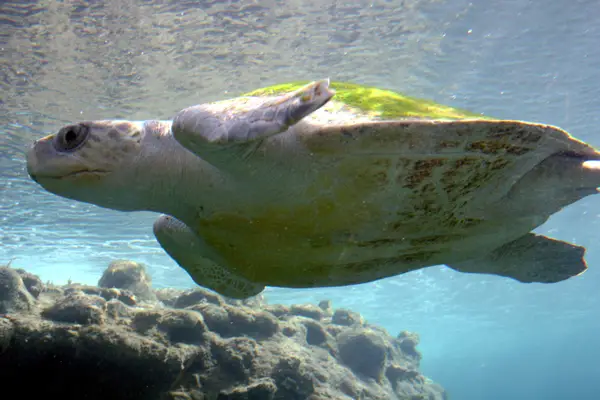
- Scientific name: Lepidochelys olivacea
- Common name: Pacific ridley sea turtle
- Family: Cheloniidae
- Size: 2.5 feet
- Lifespan: 50 years
- Conservation status: Vulnerable
Olive ridley sea turtles are protected under the federal Endangered Species Act. The biggest threats they face are harvesting for their skin and meat and marine pollution.
These sea turtles are much smaller than other species of sea turtles. They reach a maximum of 2.5 feet in length and weigh up to 100 pounds. And they have an average lifespan of up to 50 years.
An olive ridley sea turtle has a heart-shaped carapace with olive to grayish-green in color. The shell features around 5 to 9 scutes. These turtles are generally omnivorous and feed on crustaceans, fish, jellyfish, mollusks, algae, and salps.
These sea turtles can opt to nest in large groups or by themselves. In the event of a mass nesting, the female turtles usually gather in large groups offshore on the nesting beaches.
This is then followed by a vast number of turtles moving ashore to nest (this event is usually referred to as arribada, a Spanish word for arrival).
The arribada is marked by numerous (hundreds of thousands) pregnant females coming ashore to lay eggs. Due to the high density of nesting experienced at the nesting beaches, the females end up digging up clutches of eggs laid by other females as they try to find a place for their eggs.
Olive ridley turtles are usually found in tropical and subtropical waters all year round. Though they tend to migrate to boreal waters when the climate gets warmer.
21. Leatherback sea turtle
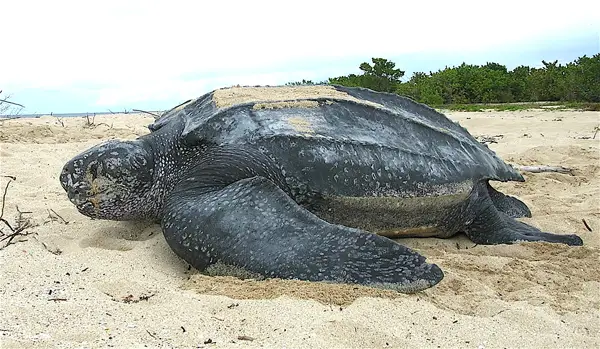
- Scientific name: Dermochelys coriacea
- Common name: leathery turtle, trunk turtle, Lute turtle, luth
- Family: Dermochelyidae
- Size: 5 to 6 feet
- Lifespan: 50+ years
- Conservation status: Vulnerable
The leatherback sea turtles are also victims of bycatch in fisheries, illegal collection of their eggs, marine population, killing the adult turtles, coastal developments, and climate change.
These turtles are known to grow to mammoth sizes (up to 6 feet!). An average adult can also weigh as heavy as 540lbs!
Leatherback turtles usually have black shells. And they differ from other species of turtles with their smooth leathery carapace and skin. Their upper shell is made up of a flexible layer of dermal bones covered by tough and oily connective tissue and smooth skin.
The body of this turtle is barrel-shaped and then tapered to the rear. They have a total of 7 longitudinal dorsal ridges and their whole body is almost completely black, with some variable spotting.
Leatherback turtles have tooth-like cusps that work closely with their sharp-edged jaws to enable them to easily feed on jellyfish, salps, and other gelatinous zooplankton.
As for the habitat, these turtles are fond of tropical and subtropical waters all year round. But they tend to migrate to cooler, temperate, and boreal waters during warm weather.
Note that this species is highly migratory and can swim as many as 10,000 miles in a year between foraging and nesting grounds. They’re also excellent divers—with the deepest diving record standing at whopping 4,000 feet!
22. Hawksbill Sea Turtle
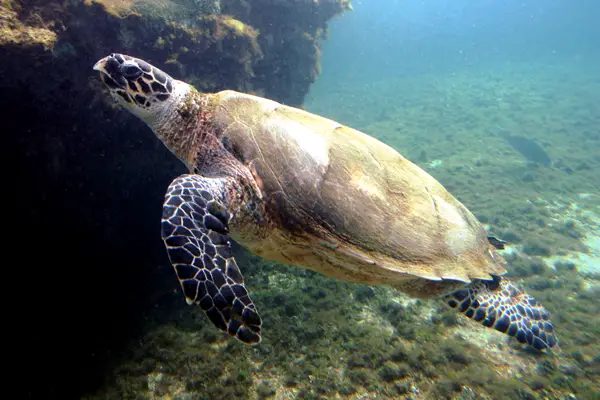
- Scientific name: Eretmochelys imbricata
- Common name: hawksbill turtle
- Family: Cheloniidae
- Size: 2.5 to 3 feet
- Lifespan: 50 to 60 years
- Conservation status: Critically endangered
Hawksbill sea turtles are listed by IUCN as critically endangered species. They suffer nesting habitat loss and coral reefs caused by coastal development. Rising seas due to climate change and marine pollution are other big threats to these sea turtles.
The adult has an average size of 3 feet and weighs around 180 pounds. The shell of this turtle features amber upper shell with irregular light and dark streaks. They also feature predominant black and molten brown easily radiating to the sides.
The shell tends to change color depending on the water temperatures.
This colored and patterned shell makes this turtle highly valuable and is commonly sold as “tortoiseshell” in the markets.
The hawkbill turtle is so named due to its narrow, pointed beak. It also has a distinctive pattern of overlapping scales on its shells which form a serrated look on the edges.
These turtles mainly feed on the sponge which they easily extract from reef crevices with the help of their narrow, pointed beaks. They also feed on jellyfish.
Hawkbill turtles are generally found in tropical oceans throughout the world. While they live in the open ocean, they tend to spend more time in various coral reefs and shallow lagoons across the US.
During nesting, a female hawkbill turtle will look for small coves, “pocket” beaches, or inlets surrounded by rocks. They tend to travel high up the beach to lay eggs in shelters formed by the plants.
23. Eastern Box Turtle
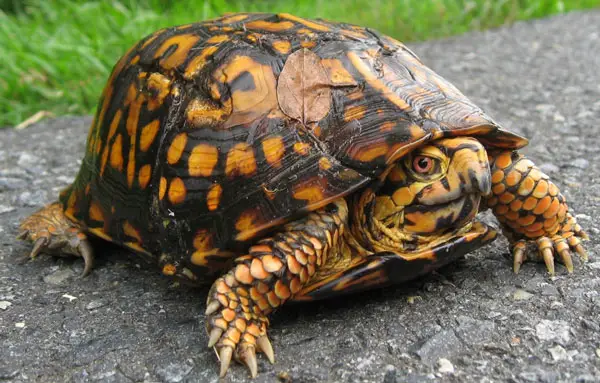
- Scientific name: Terrapene carolina
- Common name: Eastern Box Turtle, Land turtle, Box Turtle
- Family: Emydidae
- Size: 4.5 and 7 inches
- Lifespan: 50 to 100 years
- Conservation status: Vulnerable
The eastern box turtles are taken from the wild for the pet trade, leading to a decline in their population. For this reason, many states have illegalized capturing and selling of this species.
And those in captivity end up dying due to poor conditions or being abandoned or released back into the wild because they’re too demanding to maintain.
They usually inhabit dense thickets and woodland areas. They prefer these areas due to abundant access to sunlight and food sources nearby.
An adult turtle of this species is about 4.5 to 7 inches and weighs just 2lbs. It has a high, domed shell shape with a ridge running from head to toe. The shell of this turtle has varying colors of olive, brown, and tan.
The variation in markings on the shells of these turtles is so variable that you can’t easily recognize one by looking at the shell alone.
These eastern box turtles are omnivorous and feed on a variety of foods including insects, meat, fruits, vegetables, and various types of vegetation.
24. Ornate Box Turtle
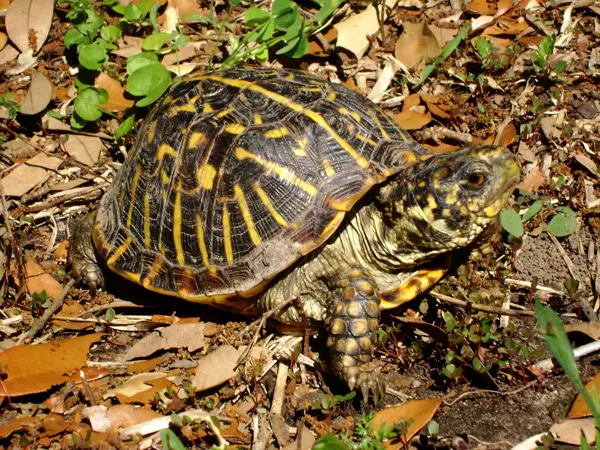
- Scientific name: Terrapene ornata
- Common name: Ornate Box Turtle, Western Box Turtle
- Family: Emydidae
- Size: 5 to 7 inches
- Lifespan: 40 to 60 years
- Conservation status: Near Threatened
Ornate box turtles have Near Threatened (NT) conservation status. They have greatly suffered habitat loss due to development, agriculture, and roads.
They are recognized by the beautiful pattern on their carapace. This eye-pleasing pattern is sometimes referred to as a starburst pattern.
Their skin is grey and may feature yellow or white spots. Male heads occasionally feature green color.
Though there exists little distinction between the males and females of these box turtles, males are generally smaller than females.
During hot weather, this turtle requires water to help regulate its body temperature.
The species of turtle are known to hibernate in burrows during cold weather. They’re also capable of surviving in frozen soils for several days.
Being omnivorous in nature, and opportunistic feeders, these turtles will gladly feed anything available to them in their habitat or what’s abundant in a given season.
They have been observed eating fruits, vegetables, grasshoppers, and various other insects.
25. Mojave Desert Tortoise
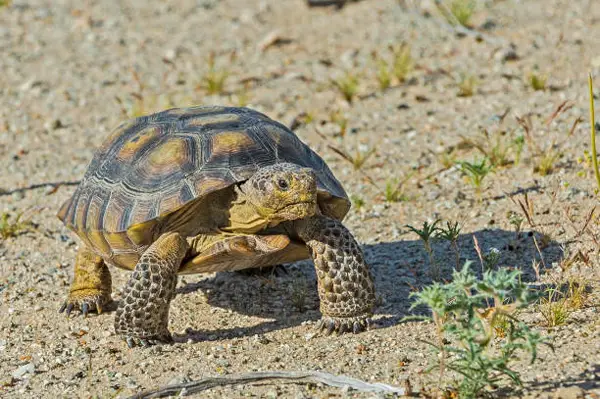
- Scientific name: Gopherus Agassizii
- Common name: Mojave Desert tortoise
- Family: Testudinidae
- Size: 10 to 15 inches
- Lifespan: 60 to 80 years
- Conservation status: Threatened
The Desert tortoise is one of the native species of Nevada. The tortoise prefers semi-arid climates in the South of Nevada, where it can survive intense heat and little rain. The tortoise also prefers living in dry grassland areas.
Unfortunately, this keystone species is threatened, mostly due to habitat loss, and is under protection by Nevada authorities.
A desert tortoise is defined by a large domed shell ranging from brown to green, while its scutes have light patches. It stays relatively inactive for the most part of the year, during which it digs caves and burrows
The desert tortoise is herbivorous and feeds on wildflowers and grass. During the summer months, it has been observed feeding on cacti and other succulents.
It’s also worth noting that the desert species of California is labeled as an “indicator species.” This means it is used to show the health of the ecosystem by observing its population health.
Unfortunately, the Desert tortoise population is on a downward trend throughout its habitat. This has been attributed to issues like mining, expansion, natural predation, and destruction of their burrows by off-road vehicles.
26. Sonoran Desert Tortoise
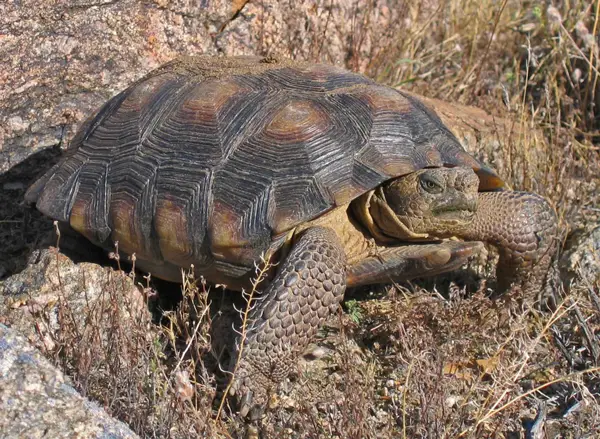
- Scientific name: Gopherus morafkai
- Common name: Sonoran Desert tortoise
- Family: Testudinidae
- Size: 6 to 14 inches
- Lifespan: 60 years
- Conservation status: Vulnerable
The Sonoran Desert tortoise lives in Arizona’s arid climate and is capable of withstanding little rain and intense heat.
Unfortunately, the Sonoran Desert turtle population is on a downward trend throughout its habitat. This has been attributed to factors such as mining, expansion, natural predation, and destruction of their burrows by off-road vehicles.
It prefers areas with firm ground where it can build burrows and use the rocks as shelter. A typical burrow for this desert tortoise has a unique half-moon-shaped opening.
This desert tortoise has been observed to spend most of its life underground and only comes out to the surface during foraging or breeding. This helps it conserve water and energy.
The terrestrial tortoise is herbivorous and eats stems, leaves, and flowers.
One great capability of this tortoise is that it can withstand ground temperatures up to 140 degrees Fahrenheit—making it one of the few species capable of withstanding extreme heat and lack of rain in the Death Valley!
The desert species is labeled as an “indicator species.” This means it is used to show the health of the ecosystem by observing its population health.
27. Gopher Tortoise
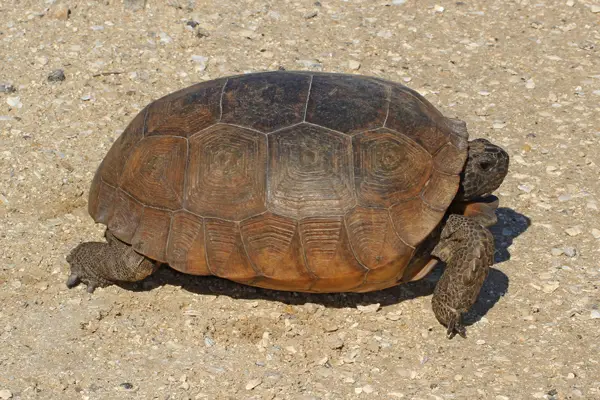
- Scientific name: Gopherus polyphemus
- Common name: Gopher
- Family: Testudinidae
- Size: 6 to 9.5 inches
- Lifespan: 40 to 60 years
- Conservation status: Vulnerable
It is illegal to domesticate a gopher tortoise as a pet in most states where it is found. They also face the threat of a declining population mainly caused by human interference.
Georgia authorities, for instance, limit land development in areas with these tortoises or their burrows. It is also illegal to relocate these species without permission from Fish and Wildlife Services.
Gopher is a fairly large tortoise. An adult has a size of 6 to 9.5 inches. They have brown or tan shell color and grayish-brown skin with yellow or orange botches.
The terrestrial reptile has its forefeet well adapted for burrowing. The front legs are scaly and shovel-like to allow for easy digging.
Mind you, this turtle gets its name from its ability to dig deep burrows—just like a gopher the rodent!
Even more interesting is that these burrows provide shelter to 360 other animals, including frogs, owls, engendered indigo snakes, etc.—making the tortoise a keystone species.
They mainly feed on vegetation such as mushrooms, grass, flowers, apples, and berries. Since they’re omnivorous in nature, they also feed on dead crabs or insects they come across.
Gopher tortoises tend to be more active during warmer weather. Their burrows can maintain more constant temperatures, making them safe havens for them.
Conclusion
There you have it! Our complete list of the most endangered turtle species in the US. These species range from alligator snapping turtles to map turtles, western pond turtles, sea turtles, box turtles, and even tortoise species.
All the species featured in this list have been listed by IUCN as vulnerable, near threatened, endangered, or critically endangered. These turtles are also state-protected and listed as species of special concern in the various states they call home.
The most common threats undermining their population include pet trade, predation, diseases, killing by fishermen, habitat loss and alteration, and road mortality.
Before collecting any of these turtle species, we advise you to check with your local authorities on whether they’re illegal to keep in your area of residence.
